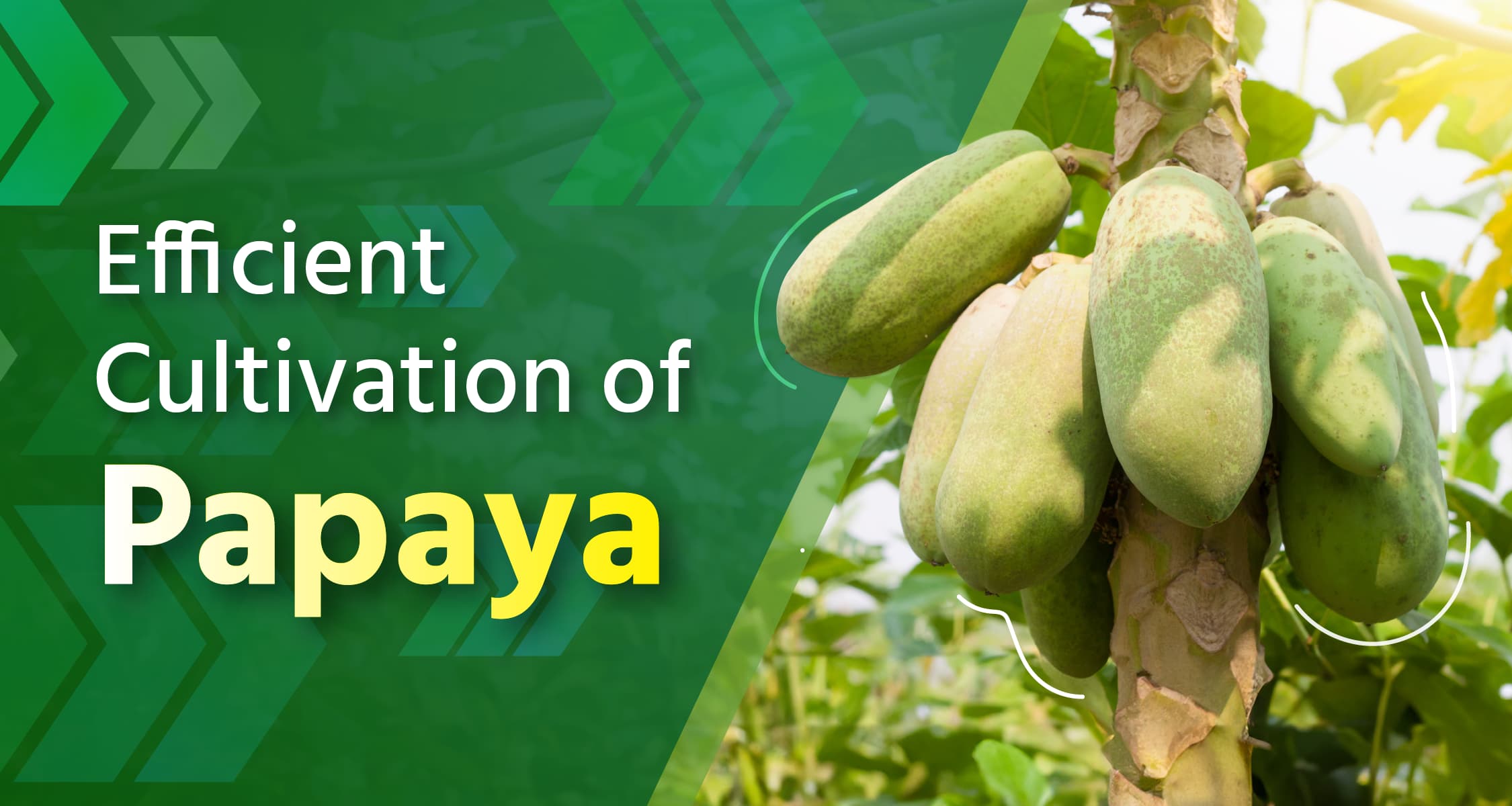पोस्ट विवरण
Papaya Cultivation: Varieties, Seed Treatment, Disease Control

Sweet and delicious papaya is quite a favorite fruit among people. Due to its richness in various nutrients, the demand for papaya is increasing. Moreover, the quick fruiting in plants makes its cultivation very profitable for farmers. If you also want to cultivate papaya, it is essential to have some important information related to it. Let's discuss in detail the factors to consider for better papaya yield.
Cultivation of Papaya
Suitable Location
- Papaya thrives in tropical and subtropical regions, requiring temperatures between 21°C to 32°C for cultivation.
- Select a suitable spot with ample sunlight and good drainage.
- Papayas need at least 6 hours of direct sunlight daily to flourish.
- Optimal conditions ensure a healthy harvest of this versatile fruit.
Suitable Timing for Papaya Cultivation
- Papaya cultivation can be done 3 times a year. September- October is ideal for planting new saplings.
- In the monsoon season, planting is carried out in June-July.
- February- March is suitable for planting in the spring season.
- Proper timing ensures optimal growth and yield in papaya farming.
Choosing the Right Soil for Papaya Cultivation
- Opt for heavy and sandy soil for improved yield in papaya farming. Soil pH levels should ideally range between 6.5 to 7.0
Seed Quantity
- For cultivating papaya on one acre of land, approximately 200 gm of seeds are required. Make sure to follow these guidelines for optimal results in your papaya cultivation endeavours.
Method of Seed Treatment
Organic Method
- For treating seeds organically, use Trichoderma viride, Trichoderma harzianum, or Pseudomonas fluorescens. Additionally, you can treat papaya seeds with organic solutions like "Beejamrit".
- For this, mix 50 gm of cow dung, 50 ml of cow urine, 50 ml of cow milk, and about 2 to 3 gm of lime in 1 liter of water and let it soak overnight. Treat the seeds with this mixture the next morning.
Chemical Method
- Before sowing, treat each kg of seeds with 3 gm of Captan.
- Treat each kg of seeds with 2 gm of Carbendazim or Mancozeb as well.
Improved Varieties of Papaya
- Red Lady F1 - Mayco
- Vinayak - VNR Seed
- Ameena - VNR Seed
- Greenberry - Ecosynk Agrotech
Method for Preparing Plants in the Nursery
- To prepare plants in the nursery, ensure proper soil preparation. Then, create beds at a height of 15-20 cm from the ground surface and at a distance of 10 cm apart.
- Sow seeds at a 4 to 5 cm depth in all the beds.
- Method for Preparing Plants in Plastic Bags
- To prepare plants in plastic bags, fill plastic bags with a mixture of soil, sand, and manure, measuring 25 cm long and 20 cm wide at the mouth.
- Sow 1 to 2 seeds in each bag.
- After the seeds have sprouted, if there are 2 plants in one plastic bag, separate one plant.
Transplantation in the Field
- Planting of saplings in the main field should be done approximately 15 days after preparing the pits in the field.
- Prepare pits approximately 6 ft apart with a depth of 50 cm and a width of 50 cm.
- During transplanting, fill all pits with equal amounts of soil and manure mixed.
- Carefully remove the saplings from the nursery when they are 15 to 20 centimeters tall and plant them in the main field.
- For 100 female saplings, 5 to 10 male saplings are required.
Disease Management in Papaya
Papaya crops often encounter the severity of two prevalent diseases.
- Stem and Root Rot Disease: This disease can affect both large and small plants. This is a dangerous disease for the papaya crop, and to avoid this you should pay extra attention to the accumulation of water in the field.
- Mosaic Disease: This is a viral disease, due to which spotted spots appear on the leaves. Apart from this, curling and complete yellowing of leaves are also serious symptoms of this disease.
What kind of challenges do you face in the cultivation of papaya? Share your answers and experiences with us through comments. Follow the 'Horticulture' channel for more information like this. Also, don't forget to like and comment on this post.
Frequently Asked Questions (FAQs)
Q: When do papaya trees bear fruit?
A: Papaya trees typically yield fruit for harvest 10 to 13 months after planting. When the fruits transition from deep green to a light yellowish hue, it's an indication of ripening. Ripe fruits emit a water-like substance when scratched, signifying readiness. It's time to harvest them at this stage.
Q: What are the different types of papaya?
A: Papayas primarily come in three varieties: Hawaiian, Mexican, and Indian. Hawaiian papayas are smooth-skinned, with a yellow-orange hue and a sweet taste. Mexican papayas are slightly smaller in size, with pink or red flesh. Indian papayas are the largest, with green-yellowish skin and flesh.
Q: What fertilizers should you use for papaya cultivation?
A: Each papaya plant requires approximately 10 to 15 kg of cow dung manure, 100 gm of urea, 400 gm of Single Super Phosphate, and 150 gm of Muriate of Potash as fertilizers.
Q: How to differentiate between male and female papaya plants?
A: Male and female papaya plants are distinguished by their flowers. Female flowers are located near the trunk and have small bulbs at their base, with a yellow color and a length of about 2.5 cm. Male flowers have long stalks between the flowers and the trunk, and they emerge in small clusters.
जारी रखने के लिए कृपया लॉगिन करें

फसल चिकित्सक से मुफ़्त सलाह पाएँ
